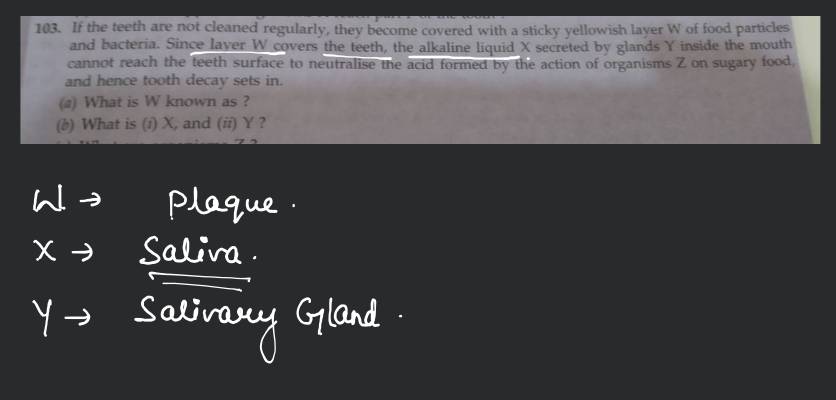Question
Question 103:
If the teeth are not cleaned regularly, they become covered with a sticky yellowish layer W of food particles and bacteria. Since layer W covers the teeth, the alkaline liquid X secreted by glands Y inside the mouth cannot reach the teeth surface to neutralise the acid formed by the action of organisms Z on sugary food, and hence tooth decay sets in.
(a) What is W known as?
(b) What is (i) X, and (ii) Y?
(c) What are organisms Z?
(d) State one way of removing layer W from the teeth.
Found 2 tutors discussing this question
Discuss this question LIVE
7 mins ago
 Text solution
Text solution Verified
Verified
Answer:
(a) W is the dental plaque.
(b) (i) X refers to the saliva, while (ii) Y refers to the salivary glands.
(c) Organisms Z are bacteria.
(c) Layer of W, i.e. dental plaque, can be removed by regular brushing of teeth.
(b) (i) X refers to the saliva, while (ii) Y refers to the salivary glands.
(c) Organisms Z are bacteria.
(c) Layer of W, i.e. dental plaque, can be removed by regular brushing of teeth.
Was this solution helpful?
43
Share
Report

One destination to cover all your homework and assignment needs
Learn Practice Revision Succeed

Instant 1:1 help, 24x7
60, 000+ Expert tutors

Textbook solutions
Big idea maths, McGraw-Hill Education etc

Essay review
Get expert feedback on your essay

Schedule classes
High dosage tutoring from Dedicated 3 experts
Practice more questions from Biology (Lakhmir Singh)
Q1
Question 102:
When a person eats sugary food, then organisms A present in his mouth act on sugar to produce a substance B. The substance B first dissolves the calcium salts from the top part C of the tooth and then from its middle part D forming holes E. These holes ultimately reach the part F in the lower part of tooth which contains nerves and blood vessels. The substance B irritates the nerve endings inside the tooth causing toothache.
(a) What are (i) organisms A, and (ii) substance B?
(b) What are (i) part C, and (ii) part D, of tooth known as?
(c) By what name are the holes E in the tooth known?
(d) Name the part F of the tooth.
(e) What will happen if organisms A reach part F of the tooth known?
(a) What are (i) organisms A, and (ii) substance B?
(b) What are (i) part C, and (ii) part D, of tooth known as?
(c) By what name are the holes E in the tooth known?
(d) Name the part F of the tooth.
(e) What will happen if organisms A reach part F of the tooth known?
Q2
Question 103:
If the teeth are not cleaned regularly, they become covered with a sticky yellowish layer W of food particles and bacteria. Since layer W covers the teeth, the alkaline liquid X secreted by glands Y inside the mouth cannot reach the teeth surface to neutralise the acid formed by the action of organisms Z on sugary food, and hence tooth decay sets in.
(a) What is W known as?
(b) What is (i) X, and (ii) Y?
(c) What are organisms Z?
(d) State one way of removing layer W from the teeth.
(a) What is W known as?
(b) What is (i) X, and (ii) Y?
(c) What are organisms Z?
(d) State one way of removing layer W from the teeth.
Q3
Question 104:
When a person puts food in his mouth, then teeth cut it into small pieces, chew and grind it. The glands A in the mouth secrete a substance B which is mixed with the food by tongue. The substance B contains an enzyme C which starts the digestion of food in the mouth. The slightly digested food from the mouth goes down a tube D. The special type of movements E in the walls of tube D push the food into stomach for further digestion. The stomach wall secretes gastric juice containing three substance F, G and H. One of the functions of F is to kill bacteria which may enter the stomach with food. The substance G protects the inside layer of stomach from the damaging effect of substance F whereas substance H is an enzyme for digestion. The partially digested food then enters into small intestine for further digestion.
(a) What is (i) gland A (ii) substance B, and (iii) enzyme C?
(b) Name the tube D.
(c) What is the movement E known as?
(d) What are (i) F (ii) G, and (iii) H?
View all(a) What is (i) gland A (ii) substance B, and (iii) enzyme C?
(b) Name the tube D.
(c) What is the movement E known as?
(d) What are (i) F (ii) G, and (iii) H?
Practice questions from Biology (Lakhmir Singh)
Question 2
Views: 5,279
(a) C2H5OH
(b) H2O
(c) CO2
(d) ATP
Question 3
Views: 5,204
(a) What is (i) organ P, and (ii) waste substance Q?
(b) Name (i) artery R, and (ii) vein T.
(c) What are tiny filters S known as?
(d) Name (i) liquid U (ii) structure V (iii) tubes W, and (iv) tube X.
Practice more questions from Life Processes
Question 1
Easy
Views: 5,676
Name the factor studied in this experiment.
Practice questions on similar concepts asked by Filo students
Question 3
Views: 5,806
Question 4
Views: 5,563


Stuck on the question or explanation?
Connect with our Science tutors online and get step by step solution of this question.
231 students are taking LIVE classes
| Question Text |
Question 103:
If the teeth are not cleaned regularly, they become covered with a sticky yellowish layer W of food particles and bacteria. Since layer W covers the teeth, the alkaline liquid X secreted by glands Y inside the mouth cannot reach the teeth surface to neutralise the acid formed by the action of organisms Z on sugary food, and hence tooth decay sets in. (a) What is W known as? (b) What is (i) X, and (ii) Y? (c) What are organisms Z? (d) State one way of removing layer W from the teeth. |
| Updated On | Feb 28, 2023 |
| Topic | Life Processes |
| Subject | Science |
| Class | Class 10 |
| Answer Type | Text solution:1 Video solution: 1 |
| Upvotes | 108 |
| Avg. Video Duration | 3 min |





